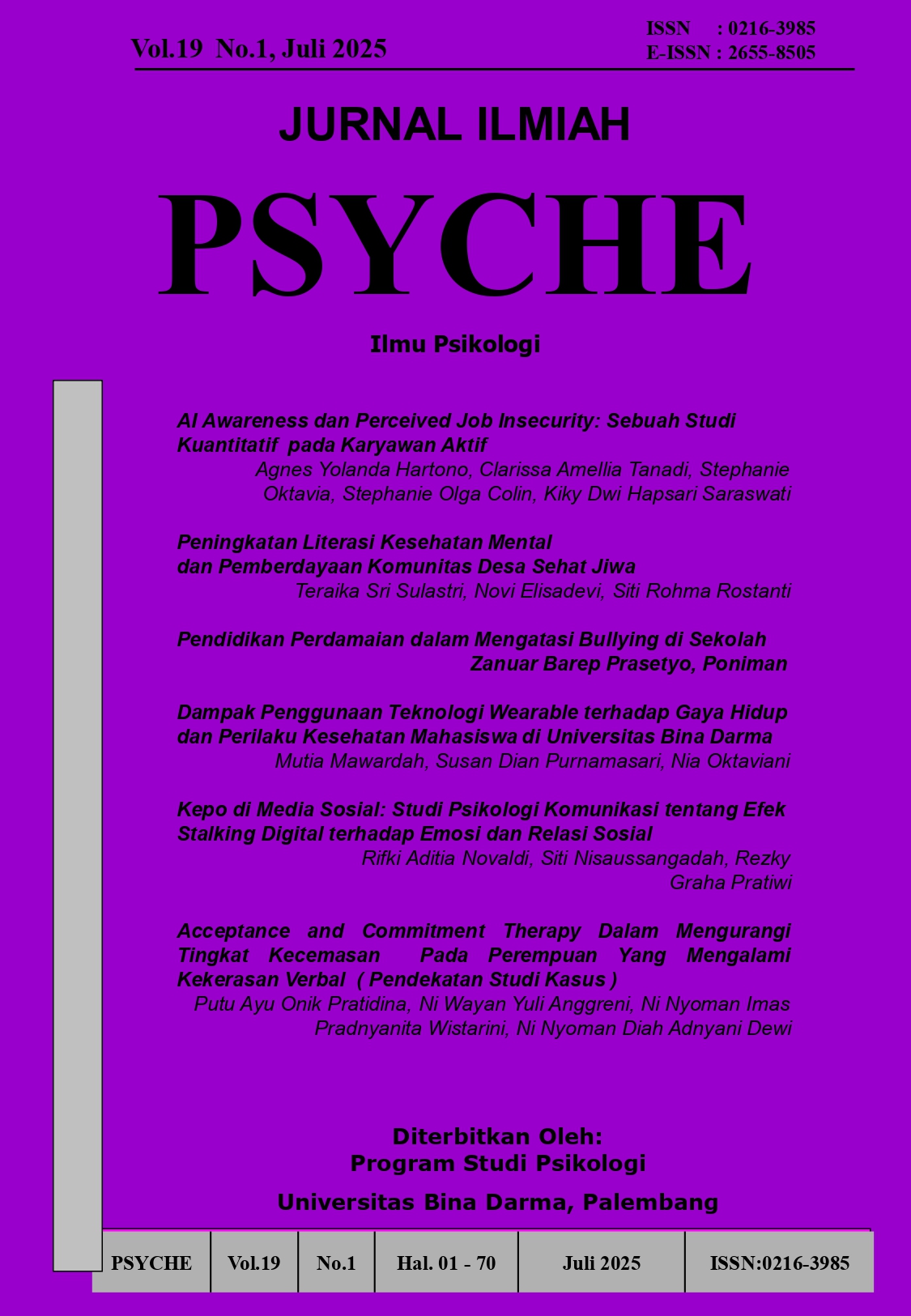Acceptance and Commitment Therapy Dalam Mengurangi Tingkat Kecemasan Pada Perempuan Yang Mengalami Kekerasan Verbal ( Pendekatan Studi Kasus )
DOI:
https://doi.org/10.33557/9bb2ej87Keywords:
ACT; Anxiety; Verbal Abuse; Woman; Case StudyAbstract
This study aimed to examine the effectiveness of Acceptance and Commitment Therapy (ACT) in reducing anxiety in an emerging adult woman who experienced verbal abuse since childhood. The research used a case study design with one participant selected through purposive sampling. The subject was a 20-year-old woman categorized as an emerging adult, experiencing high levels of anxiety due to prolonged verbal abuse during childhood. A mixed-methods approach was applied, combining qualitative data from interviews and observations, and quantitative data using the GAD-7 anxiety scale. The ACT intervention used an A-B design, consisting of one baseline phase and one treatment phase, with a total of four treatment sessions. Quantitative analysis compared GAD-7 scores before and after ACT, showing a reduction in anxiety from the severe to the mild category. Qualitative findings further supported this result, revealing behavioral changes in the subject. Initially fearful of new social situations and hesitant to take new opportunities, the subject began to engage more confidently with new people and activities. The subject also showed improvements in classroom participation and online self-expression. These findings indicate that ACT can effectively enhance psychological flexibility and reduce anxiety, especially in early adult women with a history of verbal abuse.
References
Clark; & Beck. (2012). The anxiety and worry workbook. The Guilford Press.
Halim, N., & Alfian, I. N. (2024). Acceptance and Commitment Therapy untuk Menurunkan Kecemasan Masa Dep
pada Emerging Adult The Application of Acceptance and Commitment Therapy for Reducing Future Anxiety in Emerging Adult. 5(3), 1077–1083.
Hayes, S. C., Strosahl, K. D., & Wilson, K. G. (2011). - Acceptance and Commitment Therapy_ The Process and Practice of Mindful Change. The Guilford Press.
Kashdan, T. B., Barrios, V., Forsyth, J. P., & Steger, M. F. (2006). Experiential avoidance as a generalized psychological vulnerability: Comparisons with coping and emotion regulation strategies. Behaviour Research and Therapy, 44(9), 1301–1320. https://doi.org/10.1016/j.brat.2005.10.003
Landy, L. N., Schneider, R. L., & Arch, J. J. (2015). Acceptance and commitment therapy for the treatment of anxiety disorders: A concise review. Current Opinion in Psychology, 2, 70–74. https://doi.org/10.1016/j.copsyc.2014.11.004
Mahoney, C. T., Segal, D. L., & Coolidge, F. L. (2015). Anxiety sensitivity, experiential avoidance, and mindfulness among younger and older adults: Age differences in risk factors for anxiety symptoms. International Journal of Aging and Human Development, 81(4), 217–240. https://doi.org/10.1177/0091415015621309
Nezhad, Z. S., Zandipor, T., & Hosseinian, S. (2016). Efficacy of acceptance and commitment therapy on fear of intimacy and self- criticism in women working in Welfare Institute of Kerman. 3(4), 35–41.
Nissling, L., Weineland, S., Vernmark, K., Radvogin, E., Engström, A. K., Schmidt, S., Granberg, E. N., Larsson, E., & Hursti, T. (2023). Effectiveness of and processes related to internet-delivered acceptance and commitment therapy for adolescents with anxiety disorders: a randomized controlled trial. Research in Psychotherapy: Psychopathology, Process and Outcome, 26(2). https://doi.org/10.4081/ripppo.2023.681
Pankowski, S., Adler, M., Andersson, G., Lindefors, N., & Svanborg, C. (2017). Group acceptance and commitment therapy (ACT) for bipolar disorder and co-existing anxiety–an open pilot study. Cognitive Behaviour Therapy, 46(2), 114–128. https://doi.org/10.1080/16506073.2016.1231218
Petersen, J. M., & Pimentel, S. S. (2024). Acceptance and Commitment Therapy for Insomnia. Acceptance and Commitment Therapy for Insomnia, 366–372. https://doi.org/10.1007/978-3-031-50710-6
Santrock, J. W. (2019). Life-span development. In Life-span development, 7th ed. (seventeent). McGraw-Hill Higher Education.
Spiegler, M. D., & Guevremont, D. C. (2016). Contemporary Behavior Therapy, Sixth Edition. Cengage Learning.
Spitzer RL, Kroenke K, Williams JW, & Löwe B. (2006). A brief measure for assessing Generalized Anxiety Disorder: The GAD-7. Archives of Internal Medicine, 166(10), 1092–1097.
Sugiyono. (2016). Metode Penelitian Kombinasi (Mixed Methods). Bandung: Alfabeta.
Teicher, M. H., & Samson, J. A. (2016). Annual Research Review: Enduring neurobiological effects of childhood abuse and neglect. Journal of Child Psychology and Psychiatry and Allied Disciplines, 57(3), 241–266. https://doi.org/10.1111/jcpp.12507
Yuwanto, L. (2019). Metode Penelitian Eksperimen (Edisi 2). Graha Ilmu.
Downloads
Published
Issue
Section
License

Jurnal Ilmiah Psyche by http://journal.binadarma.ac.id/index.php/jurnalpsyche is licensed under a Creative Commons Attribution-ShareAlike 4.0 International License.









